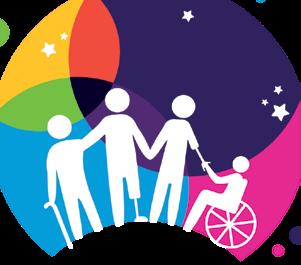
5 minute read
Florida Residents with Disabilities and Oral Health Needs
By H. Barry Waldman, DDS, MPH, PhD; Allen Wong, DDS, EdD; and Steven P. Perlman, DDS, MScD, DHL (Hon)
By the Numbers 1
In 2019, (among the civilian non-institution population) in the United States, 41.7 million people (12.5%) had a disability. In the state of Florida, 2,890,190 people had a disability (numbers rounded):
Disability: • 1,400,000 males • 1,500,000 females • 2,300,000 whites • 400,000 blacks • 69,000 with two or more races • 563,000 Hispanics (of any race) • 53,000 Asians By age: • < 5 yrs. - 7,700 • 5-17 - 187,000 • 18-34 - 281,000 • 35-64 - 982,000 • 65-75 - 550,000 • 76 + - 883,000
Type of disability: • Hearing – 824,600 • Vision – 538,100 • Cognitive – 1,071,200 • Ambulatory – 1,542,000 • Self-care – 569,500 • Independent – 1,037,000
Health Care Costs 2
•Disability Healthcare costs in Florida for adults: • About $53.1 billion per year, or up to 35% of the state’s healthcare spending.
•About $15,811 per person with a disability.
Some of the health disparities
Adults with disabilities in Florida experience health disparities and are more likely to: With disabilities Without disabilities
•Be obese 32% 23% • Smoke 25% 12% • Have diabetes 16% 7% •Have heart disease 12% 4%
Large proportions of older adults in Florida continue to go without a wide range of needed vaccinations. Although race/ethnicity and disability status were shown to have some association with acceptance of vaccines, having a regular source of care, employment and income also were shown to be important predictors. 3
Among adults 18 years and older in Florida, 33.3% of individuals with disabilities, compared 12.7% of individuals with no disabilities, could not see a physician in the past 12 months, because of cost. 4
Specifically, oral health
“Individuals with developmental disabilities face major challenges in accessing oral health care, regardless of their
socioeconomic status, and suffer disproportionately from oral-related health issues, such as malnutrition, speech problems, and potentially fatal oral infections.” 5
Many individuals who have disabilities and/or complex health conditions do not have adequate access to comprehensive oral health care. Data from a Florida Behavioral Risk Factor Surveillance System emphasized the reality that more Floridians with a disability reported not seeing a dentist due to cost compared to people without disabilities (30% versus 16%). Floridians with disabilities were 60% more likely to report cost as a barrier to dental care. “Improving access to dental care for this population will require financial considerations.” 6
Florida Dental Medicaid
Previously unreported barriers to dental practitioner participation in Florida Medicaid emerged as a result of: “1). dentists’ perception of social stigma from other dentists for participating in Medicaid, and 2). the lack of specialists to whom Medicaid patients can be referred.” 7
“Florida Medicaid adult benefits cover the following emergency-based dental Medicaid services: Limited exams and X-rays, dentures, teeth extractions, sedation, problem-focused care and pain management. The dental practitioner must substantiate medical necessity and, in some cases, obtain advance authorization.” 8
According to the 2019-2020 Florida Workforce Survey completed by licensed dentists, 14,099 of the 16,089 dentists applying for re-licensure responded. Of the responses, 10,869 dentists indicated they actively practice in Florida.
•70.42% (7,515) of active Florida dentists responded they saw no Medicaid patients. Of those who did see Medicaid patients, only 12.89% (1,375) indicated they saw more than 100 Medicaid patients per year.
•In the past 12 months, 15.64% (1,681) indicated they saw no special needs patients, 55.27% (5,942) saw one-10 special needs patients, 21.2% (2,280) saw 11-50 special needs patients, 3.52% (361) saw 51-100 special needs patients and 4.37% (470) saw more than 100 special needs patients. 9
The Future
In past years, individuals with disabilities all too often “did not exist.” They were kept out of sight in institutions or the back rooms of homes. In 1958, 1972 and 1986, when we graduated from dental school, there were NO EDUCATIONAL REQUIREMENTS (lectures or clinical requirements) to ensure the preparation of dental students for the special needs of individuals with disabilities. It is no wonder, that “older” practitioners are able and willing to provide care to an endless array of patients but are unwilling and often unable to provide care for individuals with disabilities.
But times have changed. Years ago, a hard-fought battle to provide the needed care for individuals with disabilities modified dental and dental hygiene school accreditation requirements. They now include mandatory preclinical and clinical requirements to include the care of these individuals. In addition, the American Dental Association Code of Ethics now specifies that dentists may not discriminate against individuals with disabilities.
The need is to provide care for more individuals with disabilities. What about mandatory continuing education requirements (at the time of license renewal) for current practitioners who received no specific training during their dental school years?
Patients vary by age, gender, race, language, personality, education, knowledge, demands, finances, health status and just about any number of other parameters that one can and can not imagine. It is these challenges that should motivate all practitioners and their staff as they provide comprehensive services for their patients. Yes, even for individuals with disabilities!
References
1. U.S. Census Bureau. Available from: S1810 Disability characteristics data.census.gov/ cedsci/table?q=Residents%20with%20disabilities%20in%20Florida&tid=ACSST1Y2019. S1810 Accessed January 25, 2022.
2. Centers for Disease Control and Prevention. Disability & Health U.S. State Profile Data for Florida (Adults 18+ years of age). Available from: cdc.gov/ncbddd/disabilityandhealth/impacts/florida.html Accessed January 25, 2022.
3. Khan SR, Hall AG, et al. Association between race/ethnicity and disability status and receipt of vaccines among older adults in Florida. Available from: sciencedirect.com/ science/article/abs/pii/S1936657417302182 Accessed January 25, 2022.
4. Centers for Disease Control and Prevention, National Center on Birth Defects and Developmental Disabilities, Division of Human Development and Disability. Disability and Health Data System (DHDS) Data [online]. Available from: dhds.cdc.gov, Accessed January25, 2022.
5. University of Florida College of Dentistry. Partnering to Improve Oral Health for the Special Needs Population. Available from: dental.ufl.edu/2021/01/26/partnering-to-improve-oral-health-for-the special-needs-population/ Accessed January 25, 2022.
6. Rapalo DM, Davis JL, et al. Cost as a barrier to dental care among people with disabilities: a report from the Florida behavioral risk factor surveillance system. Available from: onlinelibrary.wiley.com/doi/10.1111/j.1754-4505.2010.00144.x Accessed January 25, 2022.
7. Logan HL, Catalanotto F, et al. Barriers to Medicaid participation among Florida dentists. J Health Care Poor Underserved. 2015, Feb; 26(1): 154–167.
8. Medicare.org Does Florida Medicaid Cover Dental Care for Adults? Available from: medicare.org/articles/does-florida-medicaid-cover-dental-care-for-adults/ Accessed January 25, 2022.
9. Florida Department of Health. (2022). 2019-2020 Workforce Survey of Dentists.










